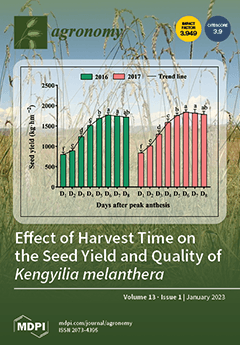The problems of high nitrogen (N) fertilizer application rate and low N utilization efficiency are common worldwide in vegetable plantations. Application of brown coal (BC, also known as lignite) can increase crop yield and fertilizer N recovery efficiency (
NRE). However, the effect of BC application on the utilization and distribution of exogenous N in the soil–plant system under different fertilization strategies is unclear. The pot experiment was set up in three factors of randomized design, including
15N-labeled urea fertilizer, BC, and organic manure, and pakchoi was used as the test crop. There were five rates of
15N-labeled urea, including 0, 100, 200, 300, and 400 kg N ha
−1, two rates of BC with 5 and 0 t ha
−1, and the organic manure with 0 t ha
−1 which constitutes ten treatments. The other four treatments were the combination of one
15N-labeled urea rate of 100 kg N ha
−1, two rates of BC with 5 and 0 t ha
−1, and two rates of organic manure with 100 and 0 kg N ha
−1. In conclusion, the interaction of all N fertilizer rates combined with BC improved soil
15N retention efficiency by 10.14% compared without BC amendment. Between 200 and 300 kg N ha
−1, the average potential loss rate of
15N decreased by 10.41%. The application of BC could reduce N loss by enhancing plant N uptake and increasing soil retention. The combined use of 200 kg N ha
−1 fertilizer and 5 t ha
−1 of BC would maintain a high fertilizer
NRE and ensure pakchoi yield.
Full article





